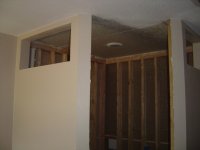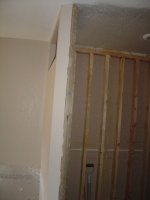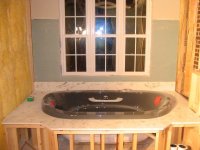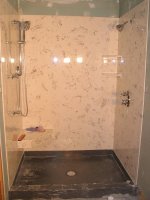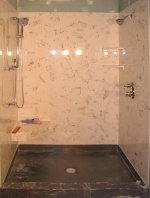Richard
Elite Member
- Joined
- Apr 6, 2000
- Messages
- 4,822
- Location
- Knoxville, TN
- Tractor
- International 1066 Full sized JCB Loader/Backhoe and a John Deere 430 to mow with
Putting together a full bath in the basement. I've bought "mold resistant" drywall for the entire room.
It's going to have a stand up/walk in shower stall instead of a tub/shower. Shower is something like 4'x4' for general conversation.
My question is, the opening above the shower door enclosure (tramway?)
Anyway, should I go ahead and use this mold resistant drywall above the doorway or greenboard (moisture resistant) or is the mold resistant essentially BOTH mold AND moisture resistant?
I'm TRYING to get the wife to agree to tile above the door and the six inch walls to each side of door. It's a corner shower and door is placed on a 'cut off' corner. (instead of a square 4x4 box, the sides extending into the room are say, 3' and that hypotunuse is where the door is.
If she agrees to tile the door side of shower, then I can simply use durock. As it is, she wants to paint this wall and that will mean drywall, or something else if you have any ideas?
I just don't want to install the wrong thing above the door where all the steam WILL in fact, be exiting.
Any thoughts?
I won't be checking back until after 4:00 as my Bengals are on their way to open a can of whoop hiney in Pittsburgh!!
Here's to a good game for both.
It's going to have a stand up/walk in shower stall instead of a tub/shower. Shower is something like 4'x4' for general conversation.
My question is, the opening above the shower door enclosure (tramway?)
Anyway, should I go ahead and use this mold resistant drywall above the doorway or greenboard (moisture resistant) or is the mold resistant essentially BOTH mold AND moisture resistant?
I'm TRYING to get the wife to agree to tile above the door and the six inch walls to each side of door. It's a corner shower and door is placed on a 'cut off' corner. (instead of a square 4x4 box, the sides extending into the room are say, 3' and that hypotunuse is where the door is.
If she agrees to tile the door side of shower, then I can simply use durock. As it is, she wants to paint this wall and that will mean drywall, or something else if you have any ideas?
I just don't want to install the wrong thing above the door where all the steam WILL in fact, be exiting.
Any thoughts?
I won't be checking back until after 4:00 as my Bengals are on their way to open a can of whoop hiney in Pittsburgh!!
Here's to a good game for both.
